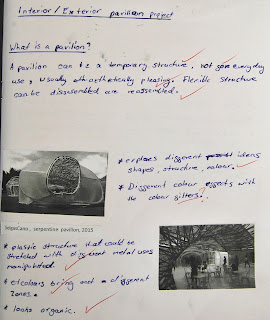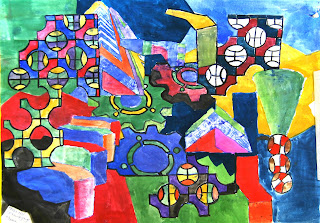STEAM Pavilion project
This Year The Art and Technology Design Department have had
a strong focus on STEAM Learning. Below is one Year 9 group's work and responses.
In art we offer methods of practice that explore the breadth
of materials and associated subjects within art; technology, design,
architecture, engineering, and allow students to consolidate these practices
into producing strong outcomes.
In this project, Year 9 pupils were set the task of creating
their own pavilions. A series of processes and materials were used to
experiment and develop their ideas into their finalised projects.
To start, pupils researched pavilions; what they are,
how they’re used, and different examples of them.
Looking at the work of Bjarke Ingels and the idea of
tessellation, students explored how these structures work, and produced
potential designs for pavilions using simple triangle shapes. This student
utilised computer software to experiment with producing his theoretical
structure designs:
Bjarke Ingels Pavilion at the Serpentine Gallery.
After this, they then produced pavilion prototypes using
nothing but triangles made from paper, the students produced very varied
responses; and the results were quite incredible.
Then they looked at artist Michael Craig Martin, whose
practices crosses pathways of painting, architecture and more. They replicated
one of his works to gain an understanding of his style and process.
Michael Craig Martin's piece
Next, using photocopied objects, they arranged their own
designs to mimic Michael’s style.
Next they used them as reference to produce lino prints.
Then they looked at Fernand Leger to explore colour, tone, and
overlapping shapes and abstract compositions. They produced watercolours in his
style, making replicas of his work.
Then they produced collages, using mechanical objects and forms from nature and graphic design.
Some Pupils went for more minimal collages, focusing
on shape, form, and greyscale tones which are very abstract and striking.
The A4 collages were scaled up and turned into A3 watercolour paintings. Pupils used vivid colours, mixing their own shades and skilfully using the media with vibrant effects.

The
final stage was selecting their desired net and applying its façade based on our
successful collages and watercolour paintings. We then painted the design on, carefully cut
out windows and doors and produced our final pieces.
Spaces were carefully cut out to accommodate windows and
doors in the pavilions; pupils really experimented and were very inventive with
this.
Next came the
all important construction!
And that concludes our fantastic STEAM Pavilion Project.





































Comments
Post a Comment